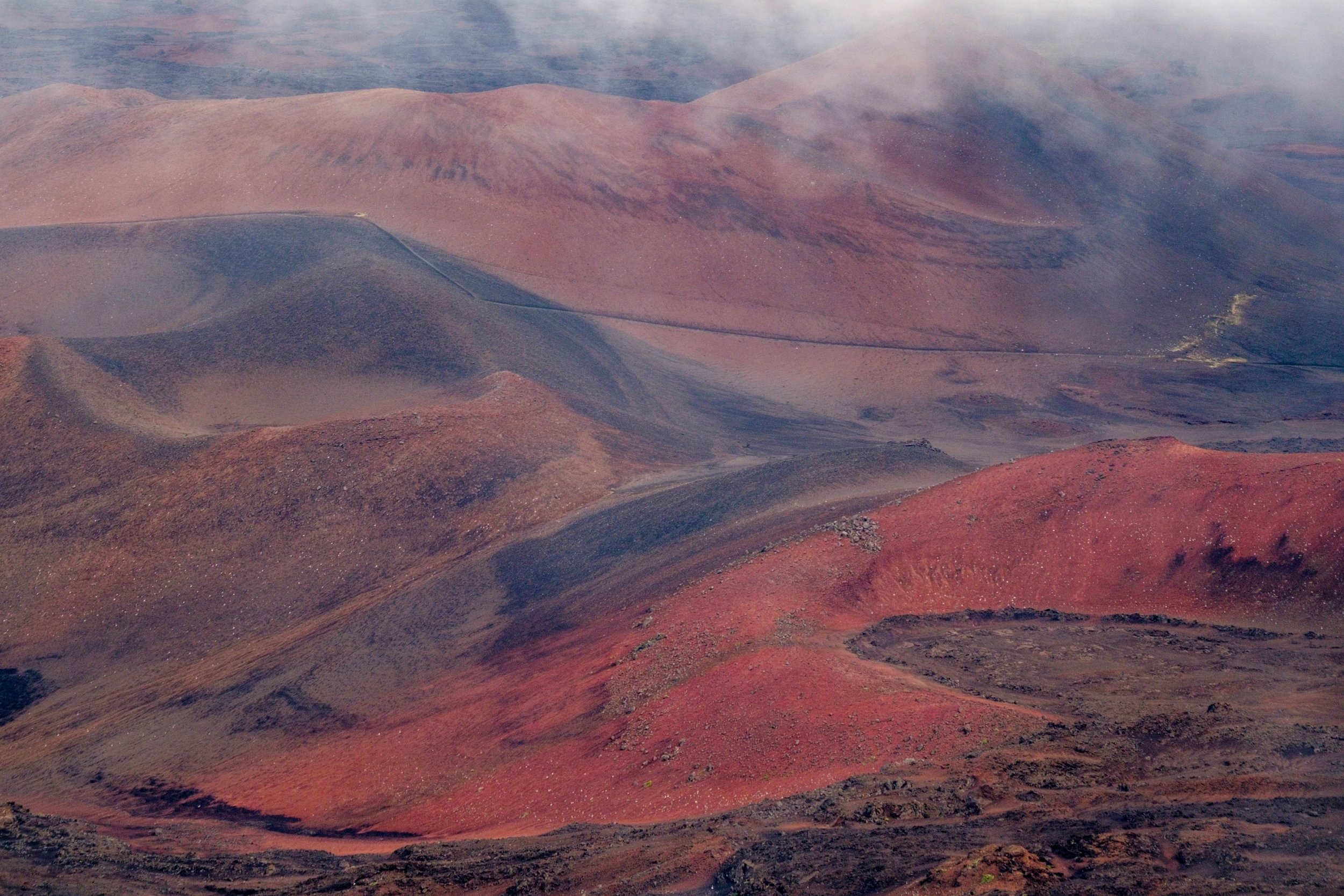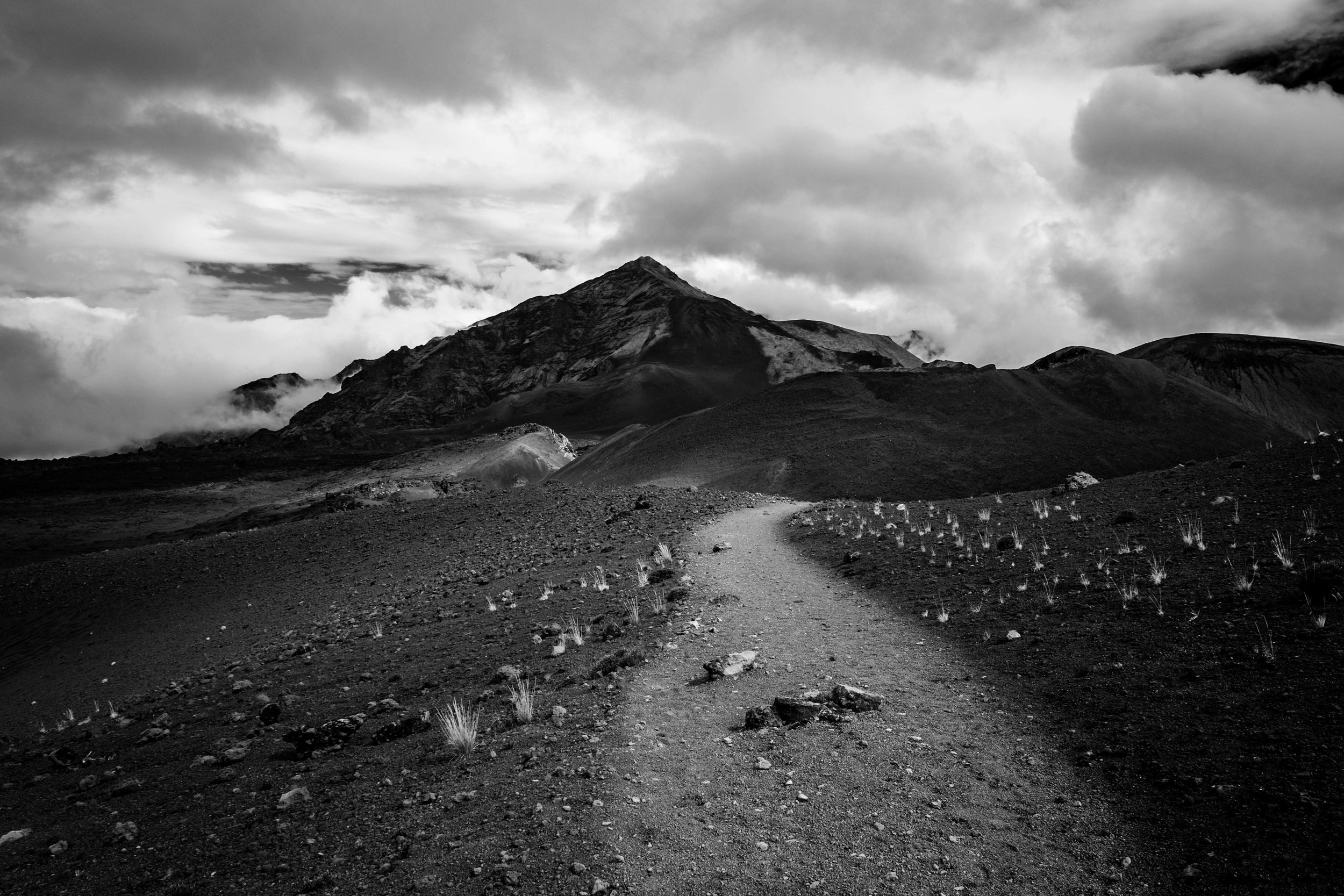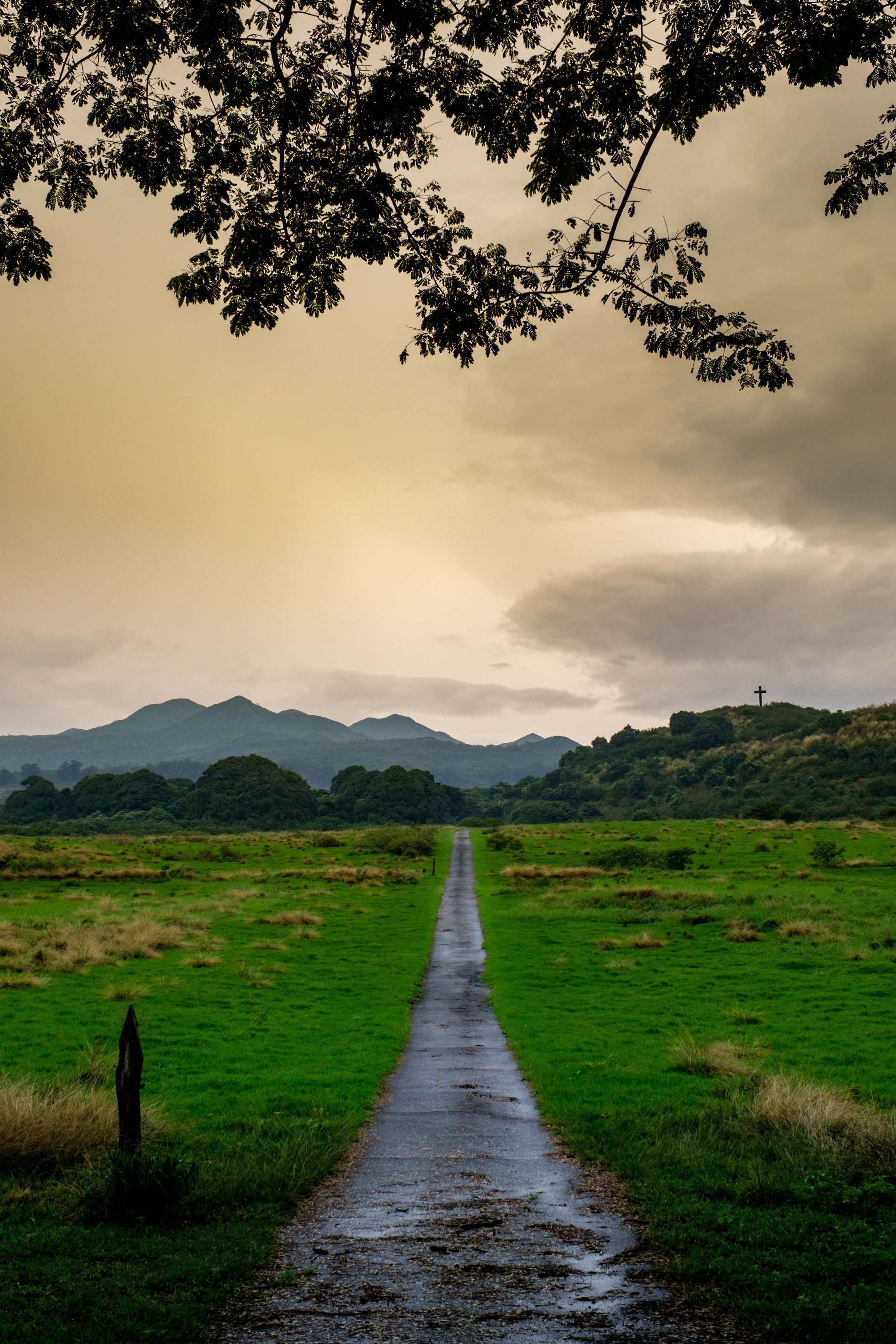Haleakala National Park, Maui, Islands of Hawai'i, USA | Park 55/59
Exploring Maui’s Haleakala National Park
Friends sharing a sunset view on the high peaks of Haleakala off of Crater Road.
Hawai'i's Haleakalā National Park on the island of Maui is one of those unique places where, in the same day, you can stand above the clouds and beside the sea while traveling through a variety of microclimates in between. "Haleakala" is the name of a giant shield volcano, where according to legend, the demigod Maui stood to ensnare the sun releasing it only after it agreed to bestow additional hours of sunlight to the island each day.
From the 10,023-foot summit to sea level is just 38 miles stretching across a world of alpine, sub-alpine scrubland, and dry forest zones all the way to the lush tropical rainforest areas full of waterfalls and streams in the Kīpahulu coastal region. Each of these areas are distinct and wonderful in their own special way and that’s what we want to share here – some of the most memorable places to explore in Haleakala.
View from the top of the Haleakala Crater just after sunrise.
Top of the Crater
The opus of this national park is found in the summit area of the Haleakalā Crater. Standing 10,023 feet above sea level, Haleakala is the highest point on the island – there you are literally on the rooftop of Maui. The viewpoint is most popular at sunrise when the dawn light bursts onto a blanket of clouds that eventually gives way to a colorful cinder-cone landscape sprawled out before you. On a clear morning, you can see the islands of Molokai, Lanai and the Big Island off in the distance.
To get there you will need to head out sometime during the 3 ‘o clock hour (am) to start the two-hour drive up the Haleakala Highway (HI 37) to the top of the crater. After waiting awhile in your car with the heat blasting and your fingers crossed that the weather will accommodate a favorable view, excitement ramps up in the parking lot as the sun fixes to burst over the horizon, stealing the show. If you stay around for a little while afterward, beautiful color intensifies on the landscape – a sight you really won't want to miss.
If middle-of-the-night exploration isn’t your thing, sunset is also a lovely time to head onto the crater rim. Not long after the sun drops behind the horizon, immaculate skygazing opportunities begin to appear including sun halos, moonbows, planets, and stars.
Either way, making a trek to the top of Haleakala isn’t an excursion; it is an event – and should you choose to face the sunrise, it is worth every precious nanosecond of lost sleep! As of February 2017, advanced reservations are needed for a trip to the summit so plan ahead.
Standing above the clouds atop Maui's Haleakalā Crater during sunrise.
Silversword blooms found along the Sliding Sands Trail.
Inner Crater
The 24,719-acre wilderness inside the Haleakala Crater passes through a wild terrain that shows colorful, sculpted landscapes and unusual vegetation the entire way. To get a taste, you'll want to plan a day hike or backpacking adventure to see for yourself what makes this one of the most popular experiences in the park.
Our recommendation is to spend a full day traversing the 11-mile Sliding Sands Trail. Desolate and artful at every turn – it is a photographer’s paradise and a hiker's dream. Along the way, you will see endangered Hawai’ian geese (the state bird, called nene) and the endangered silversword plant (ahinahina) which is endemic to the crater and looks electric against the volcanic landscape. Virtually alone in such a vast environment, you will find yourself marveling at the stillness and wondering where on Earth you actually are... it is without a doubt one of America’s most epic hiking trails!
Surreal terrain washed with rich color on the cinder-cone landscape of the Haleakala Crater.
The Coast
A view of some of the Seven Sacred Pools in the Ohe'o Gulch.
In the Kipahulu district, stretching down the east side of the island, rainforest and water features converge to protect countless wildlife, birdlife, and insect species inside of a rich jungle ecosystem. The Pools of Ohe’o, AKA the “Seven Sacred Pools,” are the top draw to the area. Fed by waterfalls, the tiered plunge pools cascade like curtains feeding into the Pacific Ocean.
While the pools are the draw of the area, the day hiking is fantastic as well. The easiest to tackle is the .5-mile Kuloa Point Trail leaving from the Kipahulu Visitor Center that winds to the mouth of the Ohe'o Gulch where you can take in sweeping coastal views of Kuloa Point.
Heading deeper into the green heart of the park is the popular 4-mile (round trip) Pipiwai Trail where you will pass through dense vegetation thrusting you upon beautiful views of waterfalls and greenery, past an enormous Banyan Tree, until you reach a dense forest of bamboo at the top of the trail where you can get lost for awhile in an ancient landscape. This is a trail not to miss!
A fairytale Banyan Tree about a mile in on the Pipiwai Trail.
Heading into a bamboo wonderland on the Pipiwai Trail in the Kipahulu area of the park.
The Road to HAna
Wailua Falls in black and white.
To get from the crater and wilderness areas of Haleakala to the coastal area in Kipahulu you travel the famed Hana Highway (Hwy 31) from Maui’s northeastern shore. The road leads to the small town of Hana – an unspoiled frontier that is known as the "most Hawaiian town on the islands."
Along its 54-mile paved one-lane highway you will wind through a jungle paradise while immersing in native cultural experiences along the way. A couple of sites not to be missed:
Surf culture is alive and well at Ho'okipa Beach just a few miles from the start of your journey, where the swells are huge and the experienced surfers who ride them are happy.
The Halfway to Hana Stand (c. 1982) is a must stop along the road where you can refuel with coffee and snacks while picking up local Hawai’ian crafts to gift your loved ones and/or commemorate your adventure.
Check out a beautiful black sand beach at Waianapapa Beach, yet another gorgeous stop along the highway that is home to sea caves, blow holes, a natural sea arch, and shores made of black sand.
Bread stands are popular spot in the coastal areas of the park. Aunt Sandy’s Banana Bread in Keane is a local favorite. Hit it as early as you can, they sell every day!
You'll want to prep your patience on this drive. There are approximately 59 one-lane bridges and 620 curves slowing the course. Locals object to the idea of building two-lane bridges because it would change the character of the historic road, increase traffic, and cause visitors to speed through, negating the "journey is the destination" idea...but you are on Hawai'ian time after all, so sit back, relax, and enjoy the spirit of aloha!
“For me its balmy airs are always blowing, its summer seas flashing in the sun; the pulsing of its surfbeat is in my ear; I can see its garlanded crags, its leaping cascades, its plumy palms drowsing by the shore.”
Quotable Images
Fact Box
34,294 acres | International Biosphere Reserve | National Register of Historic Places (Haleakala Crater)
Official name: Haleakala National Park
Location: Maui, Islands of Hawai’i
Date established: July 1, 1961
How the park got its name: The word "Haleakala" means ‘House of the Sun’ in the Hawai’ian language. As legend goes, the demigod Maui captured the sun and held it captive until it agreed to slow its path across the sky, extending the length of day on Maui.
Iconic site in the park: The view from the Haleakalā summit of the crater at sunrise is one of the most popular experiences in all of Hawai’i and with good reason! There you will stand above the clouds looking upon an ever-changing skyscape that breaks after sunrise to reveal a vibrant volcanic landscape. Anything that gets hundreds of people to start their morning at 3:00am to make a drive to the top of a crater at 10,023 feet has got to be good, right? It's every bit as good; legend is more like it.
As of February 2017, advanced reservations are needed for a trip to the summit so plan ahead of time. The Park Headquarters Visitor Center is located 2/3 the way up at 7,000-feet above sea level; the Haleakala Visitor Center at the crater is at the summit. There you can get information on day hikes in the area and they are not to be missed.
Sunrise view of the clouds hugging the crater atop Haleakala summit in December, 2016.
Accessible adventure: In the Hana rainforest preserve in the Kipahulu district on the east side of the island is a fantastic short hike that offers a taste of the area in a short amount of time. The half-mile Kuloa Point Trail starts at the National Park Visitor Center where there is a Hawaiian cultural demonstration. From there, you will head out to meet beautiful panoramic coastal views before entering a small forest of vegetation. This is a terrific place to take a closer look at the landscape – particularly its unique foliage, insects, and birdlife – before it opens up at a lookout area over the Kuloa Point where the icy Pacific seas crash into a rocky shoreline. Rogue waves and turbulent waters prohibit the wise from swimming here, but that's okay because the hiking and scenery is divine!
Detail of a Hawaiian Garden Spider seen on the Kuloa Point Trail in the Kipahulu area of Haleakala National Park.
Big adventure: For the adventure circuit who might rather traverse an ancient crater than sip a blue drink beside the sea, there is a penultimate hiking journey to be found along the 11-mile Sliding Sands Trail. While the hike is relatively popular, you will find yourself with nobody around as you make your way into the colorful crater. The trail crosses such a large variant of diverse terrain that you will feel as though you've crossed the entire state (or other planet) by the time you’ve completed the hike. The last push continues winding up a misty, jungly mountainside for what seems like forever (actual distance: 1,000-feet.) Your legs will be fried at the end but it is 100% worth the effort – this is one of the most beautiful, challenging, rewarding, and unique day hikes in all of the national parks!
Otherworldly landscapes to explore as you venture into the inner crater at Haleakala.
Jonathan futzing with his Fujifilm X-T1 during sunrise atop the crater.
Did you know…
The Haleakala crater is also known as the "West Maui Mountains." This is the area where the first volcano on Maui rose from the sea more than 2 million years ago.
You can see the crater of Haleakala from almost any point on the island.
The active shield volcano is in the midst of a long slumber. It last erupted in 1790 and is expected to erupt again.
The extreme elevation change between the summit and sea level makes for interesting weather. Arm yourself with protection during your visit by carrying sunblock, sunglasses, water, sturdy shoes, and plenty of snacks and water (there is no food sold in the park).
The summit of Haleakala is about 30,000-feet tall measured from the ocean floor to the summit. Together with Mauna Loa and Mauna Kea in Hawai'i Volcanoes National Park, they are the three tallest mountains on earth!
Haleakala and Hawai’i Volcanoes were considered one national park – called Hawai’i National Park – until 1960 when they were officially separated into two.
There are more endangered species in Haleakala than in any other national park. It is home to thousands of species of animals, reptiles, birdlife, and amphibians.
The endangered Silversword can only be seen in Haleakalā National Park.
Rainbow eucalyptus are among the world's most colorful trees.
The endangered silversword blossom takes about 50 years to bloom and after it flowers it will never bloom again.
Rainbow eucalyptus are among the most colorful trees on Earth. Most tree species reserve color for their flowers and leaves – this tree sucks it straight into the tree bark, giving the appearance that it was painted with long brush strokes. Earth as art!
A halo forms at the summit of Haleakala.
With low light pollution and close proximity to the sky at high elevations, Haleakala is a popular place for Skygazing. Any experience at that high-elevation could wield rainbows, halos, moonbows, planets, and stars.
What is that unique observatory near the summit? The Haleakala Observatory has monitored a variety of astrophysical experiments in that location for more than 40 years. One of its missions us to track satellites and debris orbiting Earth.
One of the most popular activities in the park is a 27-mile bike ride starting at the crater rim descending 6,500' to the historic town of Makawao at sea level. To brave this adventure, you must weigh less than 280 pounds, be taller than 4’10”, and cannot be pregnant. Bike It Maui offers guided trips for $145 a pop.
Wailua Falls, a popular stop on the Road to Hana.
Wailua Falls is a popular stop along the road to Hana. There is another waterfall with the same name located on the island of Kaui – it was featured in the opening scenes of the film Fantasy Island.
Taro plants abound in the coastal areas of the national park. Taro root is the main ingredient in Poi, a traditional food in Hawai'i. The consistency of the puree is described as "1, 2, or 3 fingers,” detailing how many fingers you'd need to eat it with.
While you can technically drive around the backside of Haleakala to the town of Hana, car rental agencies don't permit their fleet along that route because of its rocky terrain that causes damage to cars. Save yourself time and punishment and take the historic road to Hana – better safe than sorry, and it's incredible!
The Pipiwai Trail in the Kipahulu district is one of the most wonderful trails on the island. The trail ascends/descends 800-feet in elevation, so it is a challenge, and the trail gets muddy. Trust us – don’t wear flip flops!!
For those of you who are enticed by the dream of swimming in Hawai’ian waterfalls, the Kipahulu district is that dream place... unfortunately, swimming in this area is dangerous due to rock falls, slides, and flash flooding; in fact, at the time of this posting, the Pools of Oeh’o are closed indefinitely for those reasons. The good news is, beyond the pools and waterfall systems lie a series of excellent day hikes that offer spectacular views of the water features and forays into a wild Hawai'ian rainforest so diverse that additional national park protection was added in 1999.
The road to Hana was completed in 1926 (before that it was more of a trail) and was paved in 1962. It is estimated that more than 1,000 cars drive on it each day.
Charles Lindbergh is buried just a couple miles south of the Kipuhulu district near the Seven Sacred Pools.
There are actually dozens of pools at the “Seven Sacred Pools.” The name was assigned a more concrete number by a marketing team long ago to encourage tourism beyond Hāna and within the boundaries of the national park.
Prone to motion sickness and heading out on the Road to Hana? It is said that chewing gum helps calm the belly.
Haleakala is open 24/7/365!


















































































































